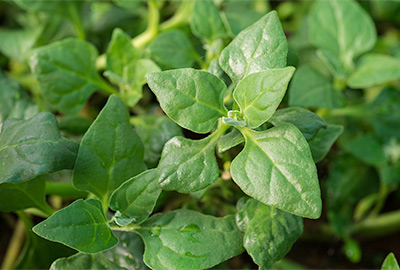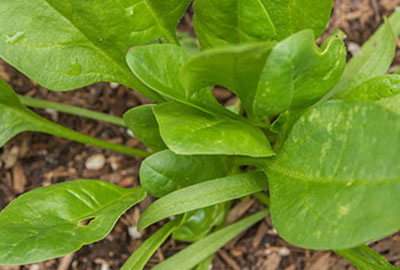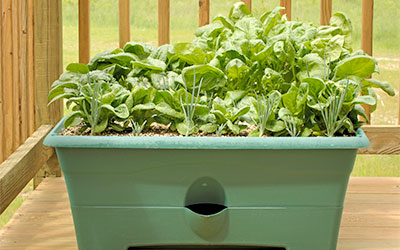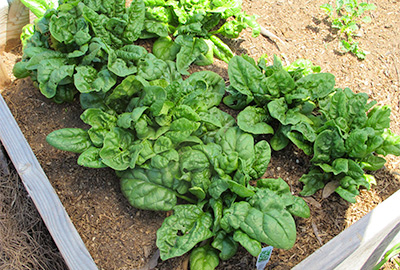Recommended Varieties/Cultivars


Some varieties of spinach are slower to bolt and more heat-tolerant than others, but no variety of Spinacia oleracea is truly heat tolerant. For a heat-tolerant green that can be used like spinach, GardenZeus recommends New Zealand Spinach (Tetragonia tetragonioides).
Lavewa is a savoy-type open-pollinated spinach variety that was an All American Selections winner in 1952, now old enough for most gardeners to consider it a heirloom. It is reliable, cold tolerant, slightly heat-tolerant, and mildew-resistant; a great all-around choice for most gardens. Bloomsdale is a classic heirloom that performs well during cool weather. Viroflay or Monstrueux de Viroflay is a vigorous, extremely productive, semi-savoyed variety with a uniquely sweet, mild flavor.
Hybrid spinach varieties may be more resilient and productive than heirlooms. Crocodile is a somewhat heat-tolerant hybrid. For a productive flat-leafed variety, try Giant 157 Hybrid. If you have had difficulty with disease or low production from heirloom spinach varieties in your garden, consider trying Melody Hybrid, a 1977 All American Selections winner known for being reliable, productive, and disease-resistant.
Buying/Selection Tips
Purchase seeds, not seedlings. Spinach is somewhat sensitive to root disturbance and transplanting, and should generally be seeded directly outdoors. GardenZeus recommends against transplanting spinach starts, especially if rootbound, as they may be prone to shock, slow establishment, diseases, pests, and other problems.
Spinach starts can be effectively transplanted about 2 to 4 weeks after germination; this is generally recommend for skilled biointensive gardeners and experienced gardeners who are willing to monitor seedlings closely, time plantings while spinach roots are still small, and handle transplants with extreme care.
Soil Needs/Tip
Spinach is somewhat fussy about soil; it is sensitive to wet soils, acidity, salinity, and compaction. It prefers loose, well-drained, slightly acidic soil, with a preferred pH range of approximately 6.5 to 7.0 and performs reasonably well with low-to-moderate soil fertility and organic matter. Spinach will produce leaves with higher nutritional value in fertile soil.
Spinach may underperform; be slow-growing or stunted; fail; or produce small, chlorotic, impalatable, or yellowed leaves in alkaline soils above 7.3 pH, in acidic soils below about 6.0 pH, in wet or waterlogged soils, or in compacted soils.
Spinach plants tend to have shallow root systems so it's important that upper soil layers are kept moist and fertile until deeper root systems can develop as a result of less-frequent, deeper watering. Spinach seedlings require good drainage for healthy root growth. Careful attention and management may be necessary to ensure adequate drainage and aeration when growing spinach in clay soils. Oxygen is displaced and quickly depleted in wet soils, which also creates conditions that encourage common root diseases.
Spinach is a light feeder, and is recommended for seasonal or annual rotation with heavier feeders such as tomatoes and squash. Avoid planting spinach in the same soil or beds more often than once every 2 to 3 years to reduce concentrations of pests and diseases.
Suitable Microclimate
Spinach grows best in full sun with cool-to-warm daytime temperatures of about 50° to 70°F. It may underperform, bolt, or become bitter above 80°F or during long summer days; and may bolt during cold and short fall-and-winter days.
Established plants can withstand short frosts to about 15° to 20°F. Seedlings and young plants may be damaged by frost. Seeds germinate at an unusually wide temperature range, in soil as cold as 35° to 40°F. Optimal soil temperature for spinach germination is about 55° to 70°F. Spinach seeds germinate more quickly at warmer temperatures above 75°F but germination percentage may also decline significantly.
At temperatures of 85° to 90°F and above, virtually all varieties of spinach (Spinacia oleracea) will suffer, become bitter, or bolt in from a few days to 2 to 3 weeks. Spinach will benefit from dappled or partial shade during warm-to-hot weather. See GardenZeus Tips for Shading Vegetables During Hot Weather for creative ideas from expert Darren Butler to provide shade.
Getting Started
Spinach is generally easy when grown during cool weather.
How many spinach plants should you grow per person in your garden? For GardenZeus expert Darren Butler's answer, see: How Much Spinach Should I Grow?: The Popeye-Bluto Garden Spinach Planner.
Many gardeners treat spinach as a "the-more-the-better, can't-go-wrong" vegetable for nutrition. GardenZeus expert Darren Butler says wait, not so fast! He has no disagreement about spinach's nutritional value but maintains a longstanding concern about lead being absorbed from soil into spinach leaves, and as a result, despite its incredible nutritional value, he has boycotted spinach, including organic spinach, for several years, unless it was grown in soil that he knows. GardenZeus encourages you to eat spinach, but only if you test your soil first and grow it yourself. For more information about spinach and lead, see Serious Gardening: Are You Eating Toxic Lead with Your Spinach and Leafy Greens?.
Watering Tips
Spinach tends to be shallow-rooted so it's important to maintain consistent moisture in the upper soil, especially while plants are germinating and establishing, and until deeper root systems can develop as a result of less-frequent, deeper watering. For commercial production, spinach is watered frequently and shallowly to maximize production of the highest-quality leaves.
While soil moisture is critical for spinach, it is also sensitive to overly wet soils, and needs sufficient soil oxygen to maintain healthy roots, particularly in heavy clay soils. Avoid overwatering or saturating soils, which encourages soilborne diseases. It's also important to provide sufficient water during warm weather to avoid wilting. When temperatures exceed 85°F, spinach may need watering more than once per day to prolong harvest and produce the best quality of leaves for its remaining harvest period.
Planting Method/Tips
Spinach seeds are large enough to plant by hand. Start seeds directly outdoors during cool, frost-free periods. Loosen soil to at least several inches or double dig beds, and add compost prior to sowing spinach seeds. Keep soil moist but not wet for starting spinach seeds.
Spinach seeds germinate at an unusually wide temperature range, in soil as cold as 35° to 40°F. Optimal soil temperature for spinach germination is about 55° to 70°F. Spinach seeds germinate more quickly at warmer temperatures above 75°F but germination percentage may also decline significantly. GardenZeus recommends not attempting to germinate spinach seeds at soil temperatures above about 80°F.
Spinach is sensitive to root disturbance and generally should not be transplanted. Spinach can be effectively transplanted within the 2 to 4 weeks after germination; this is generally recommend for skilled biointensive gardeners and experienced gardeners who are willing to monitor seedlings closely, time plantings while roots are still small, and handle transplants with extreme care.
You may wish to plant spinach seeds successively every 2 to 4 weeks during your planting season to ensure an ample supply. How many spinach plants should you grow per person in your garden? For GardenZeus expert Darren Butler's answer, see: How Much Spinach Should I Grow?: The Popeye-Bluto Garden Spinach Planner.
Spacing
Plant spinach seeds about 1/2 inch deep and 1 inch apart, or broadcast seeds in a garden bed or area and cover with a layer of fine soil. Thin as needed to final spacing of about 6 inches. Larger and upright varieties may require spacing of 10 to 12 inches; if growing upright varieties of spinach to full size for harvest of mature plants, GardenZeus recommends spacing of about 12 inches. Close spacing may stress spinach plants and encourage early bolting.
Timelines
5 to 10 days or longer to seed germination (may take 2 to 3 weeks or longer during cool weather). Seeds germinate more quickly at warmer temperatures but a larger proportion of seeds may fail to germinate at soil temperatures above 75° F.
Begin thinning 1 to 2 weeks after germination.
Transplanting is possible about 2 to 4 weeks after germination but recommended for bioiontensive and skilled gardeners only.
12 to 30 days after germination to early harvest of small leaves and thinned plants.
Thin to final spacing by about 2 to 4 weeks after germination.
35 to 65 days from germination to harvest of large leaves and full plants, depending upon variety and growing conditions. Baby spinach may be ready for harvest in 15 to 40 days, depending on variety, growing conditions, and size preference.
Harvest Period: During cool weather and if harvesting single outer leaves rather than entire plants, spinach harvest may last a few or even several weeks.
Pollination Needs/Tips
Because we eat the leaves of spinach plants, we prefer slow flowering (slow bolting), and are generally not concerned with pollination unless saving seeds.
Interplanting/Companion Planting
Spinach is generally unfussy as a garden neighbor to other plants, and may be interplanted with many other vegetables. Strawberries and spinach are traditional garden companions.
Brassicas such as broccoli and kale are also traditional companions for spinach, but GardenZeus expert Darren Butler recommends avoiding these combinations because some micorrhizal fungi may be capable of extracting nitrogen from living brassica plants to the possible benefit of spinach but to the detriment of the brassicas. Darren generally disagrees with most claims about usefulness of companion planting with brassicas, and has found that he succeeds best with brassicas when they are kept to themselves and planted at least several feet away from other garden vegetables and most other plants.
If seeding before or during warmweather, spinach may benefit from being planted near taller vegetables or other plants to the southwest so the spinach is shaded during warm afternoons.
Be cautious with planting spinach repeatedly in the same soil or beds, or near other members of the beet family (Chenpodiaceae) such as beets, chard, and quinoa, as this may tend to concentrate or increase problems with pests and diseases.
Nutrient/Amendment/Fertilization Needs/Tips
Spinach requires minimal soil fertility, particularly sufficient nitrogen and phosphorous (60 parts per million is a common commercial-farming minimum for phosphorous) and prefers reasonable levels of soil organic matter. Nitrogen is often the limiting nutrient in growth of spinach. GardenZeus recommends adding nitrogen as a soil drench in the form of diluted urea or a cup of chicken manure diluted in 4 gallons of water (half cup if fresh manure) and mixed thoroughly after seedlings are 2 to 3 inches tall and about twice per month thereafter when actively harvesting outer leaves. Overly rapid plant growth from too much nitrogen may encourage insect infestation.
Mulching
Use 1/4 inch fine mulch for small starts under 2 inches in height; increase to 1/2 inch or more of fine-to-medium mulch after plants are 6 to 8 inches tall. Avoid covering root crowns or stems of spinach with mulch, as this may encourage stem or leaf rot and other diseases.
Pruning/Cutting Back/Pinching/Separating
GardenZeus does not recommend cutting back or pinching spinach leaves except for harvesting. Cutting back the flower stalk or inflorescence of a spinach plant may extend the harvest of leaves by a few days to a few weeks. Spinach tends to become bitter earlier in the process of bolting than other greens; extended harvest might or might not be desired depending upon intended use of leaves and flavor tolerance.
Propagating
From seed. GardenZeus recommends open-pollinated, untreated, organically grown seeds.
Container Gardening

Spinach is ideal for container gardening. All varieties of spinach are appropriate for growing in containers during cool weather and otherwise appropriate growing conditions. GardenZeus recommends pots or containers at least 6 inches deep, although with careful attention and frequent watering, spinach can be grown in containers as shallow as 3 or 4 inches.
See GardenZeus Tips for Container Vegetable Gardening for general information and tips about growing vegetables and herbs in containers.
Seasonal Care
Start seeds directly outdoors during cool and frost-free periods well before your growing season becomes consistently warm-to-hot.
Spinach harvest may be extended somewhat during warm weather by providing shade. See GardenZeus Tips for Shading Vegetables During Hot Weather for creative ideas from expert Darren Butler to provide shade.
How to Harvest

Thin young plants for early salads.
To maximize spinach yield over the longest possible period, pinch off or snip off the largest, outermost leaves, low on the midrib or central vein of each leaf, allowing the plant to continue producing new leaves from the growing point at its center. Keep in mind that larger spinach leaves may tend to be bitter, especially on older plants and during warm weather, so you may prefer to harvest newer leaves.
To maximize total yield and avoid stunting plants, avoid harvesting single leaves until spinach plants are at least 6 to 7 inches tall. GardenZeus recommends harvesting about 10% to 20% of a plant’s leaves every 5 to 10 days from vigorous, actively growing plants. Overharvesting will significantly slow growth of new leaves because the plant is using leaf surfaces to capture the energy needed to grow new leaves.
Harvesting Tips
During warm periods, harvest spinach in the morning while leaves are crisp after cool overnight temperatures.
When spinach plants begin to bolt or form a flower stalk, you may wish to harvest the entire plant by cutting it at the root crown. It may be possible to extend harvest slightly by cutting off the flower stalk and continuing to harvest individual leaves, but spinach tends to become bitter quickly after bolting, more so than many other garden greens.
Spinach harvest may be extended somewhat during warm weather by providing shade. See GardenZeus Tips for Shading Vegetables During Hot Weather for creative ideas from expert Darren Butler to provide shade.
Preservation, Storage, and Use
Be diligent about removing the grit and sand from spinach before using. Pinch the leaves off the stems, then fill a basin with cold water and submerse the leaves, allowing the grit and sand to sink to the bottom. Lift out the spinach. Repeat this process until no more grit or sand appears in the basin. Place in a salad spinner or on a paper towel to remove excess moisture.
Spinach benefits from rapid chilling if not used immediately after harvest. Store at 32° F at maximum humidity in perforated plastic bag from 10 to 14 days.
Spinach is highly sensitive to ethylene gas, so place stored spinach away from ethylene fruits.
If you must harvest more spinach than you can eat in the next 10 to 14 days, GardenZeus recommends freezing. Blanch spinach in boiling water for 30 seconds to 2 minutes, until the green color of the spinach brightens, then immerse in ice water to cool quickly and prevent overcooking. Blanching softens leaves and stems, which makes them easier to work with when preparing for freezing, and helps to preserve nutrition and flavor. Remove air from freezer bags using a vacuum sealer or manually with a straw to minimize freezer burn. GardenZeus recommends using frozen spinach within 60 days, but flavor and quality may be reasonable for longer periods.
Popeye and Catherine de Medici were right: spinach is a nutritional powerhouse, high in numerous vitamins and minerals including A, B6, C, K, folic acid, riboflavin, iron, potassium, and manganese.